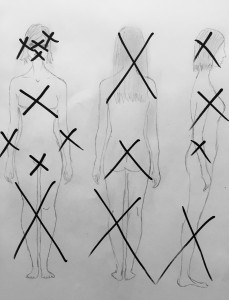Of Silenced Sexuality
October 27th, 2015
In most of the areas we encountered thus far, some narrative of the female was ever present. The woman is presented as the impure, the deviant one. Eve was the one that provoked Adam. In the Children of the Alley, we see that this is portrayed by the wife of Adham in the Children of the Alley. Mahfouz, the author, tries to correct this interpretation through Adham’s admittance of the blame. The foundation of humankind is based on the idea that woman leads astray. How do we, then, even begin to think about the mutilation of women or rape (that we see in Suns of Independence), and the inheritance of wives as well the traditions of polygamy when the entity of woman is considered the one that causes sin, and therefore, sinful? Moving on to We Sinful Women, we have writers from Pakistan that discuss the same concept. This piece is mostly inspired by the Pakistani poetry by women that we read but applies to many of the other writings as well. It depicts the human body, of female gender, and the social interpretation of the parts of the body. I’m not saying the social stature of woman/women because it is important to note that the inherent differences emerge from difference in biology. But, why is that so important or sinful? Why must women cover their heads, why must there be excision, why must bare chests of women are an atrociously sinful sight while men can go around bare. Here, I am only trying to point out the differences. It is poignant that we think of these things. Because precedent entails, or religion prescribes are reasons not enough to satiate the mind. Many a times, we ended up concluding that somehow, somewhere along the way, the interpretation of women’s status in Islam became inundated with cultural practices and withered from its true approach of the position of women. If the female body is so sexualized, why must we undermine female sexuality? Yet, we see that happening. Even today, in Africa, excision as well as the ironing of breasts is a common practice. The ‘clitoris is impure, evil’ says Suns of Independence. Women sexuality is unalloyed and unacknowledged. In the poems of Fahmida Riaz, I received the greatest literary shock of my life to discover that women in Pakistan were addressing topics such as sexuality in their work. The uber strong poem, ‘Chador’, is a counter narrative to the covering of the female body. It reverses the argument and inflicts it on the enforcer. The Hudood Ordinance in Pakistan saw great detriment to the standing of women in society, but yet, we have women standing up and saying no to enforcement of anything. The art piece depicts the rejection of the female body in many cultures. The baring of legs and arms is an offense against God knows who. The rest of the body is sexualized to such an extent, and for such unnecessary purposes. The hair is also apparently a powerful sexual tool. Even the eyes are covered too in some cases. Yet, the female sexuality remains ignored. It is not a thing befitting women, but only men. God only knows why.

Leave a Reply